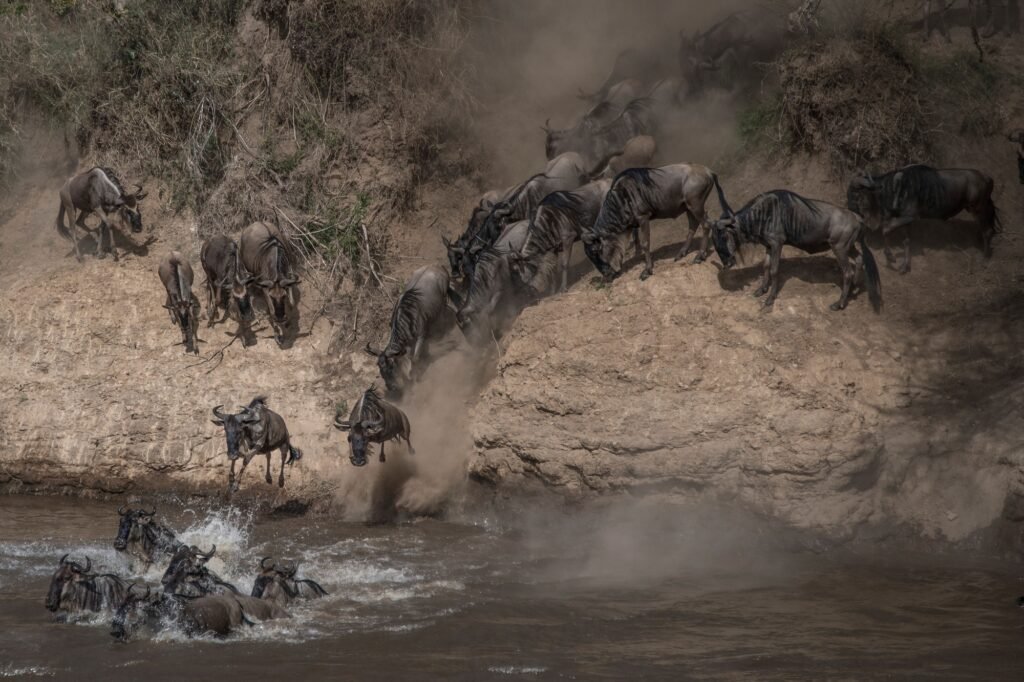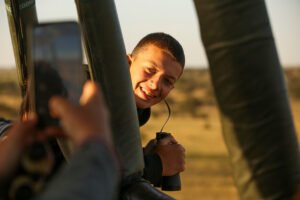


Explore the full story behind the Wildebeest Migration Migration in Tanzania. Learn how it works, why it happens, and what makes it the greatest wildlife show on Earth.
Every year, over 1.5 million wildebeest, along with hundreds of thousands of zebras and gazelles, make a circular journey through the Serengeti ecosystem in Tanzania and into Kenya’s Maasai Mara. This incredible event, known as The Great Migration, is one of the last large-scale, free-moving animal migrations left on the planet — and it’s a must-see safari experience.
It’s not just about movement — it’s a survival story, a natural rhythm driven by rainfall, grass growth, predator pressure, and ancient instinct.

The migration follows a continuous, clockwise loop through Tanzania and Kenya, covering about 1,800 miles (2,900 km). Here’s how it unfolds:
January – March: Calving Season (Southern Serengeti / Ndutu Area)
Best for: Births, predator action, and photography.
April – May: Rainy Season Movement (Central Serengeti)
Best for: Lush scenery, fewer crowds, and dramatic landscapes.
June – July: Grumeti River Crossing (Western Corridor)
Best for: Action-packed viewing and predator-prey tension.
August – October: Mara River Crossings (Northern Serengeti)
Best for: Peak migration scenes, drama, and incredible photography.
November – December: Return to the South
📍 Best for: Scenic drives and early migration movement.

The primary driver is survival. Wildebeest migrate to:
Their journey keeps the ecosystem healthy by:
It’s a perfect example of how interconnected and balanced nature can be.
Research shows wildebeest rely on:
Ongoing studies help us understand:

Despite its grandeur, the migration faces serious threats:
Thankfully, efforts by Tanzania National Parks (TANAPA), local communities, and international conservation groups aim to protect migration routes and educate travelers.
🗓️ Book early — peak migration seasons fill up fast!
The Great Wildebeest Migration is more than a safari — it’s a moving miracle, an ancient cycle that continues to awe travelers, scientists, and conservationists alike. Whether you’re watching thousands leap into a river or standing in silence as a newborn calf takes its first steps, you’re witnessing something that few places on Earth can still offer.
Ready to follow the herds? Let us help you design a migration-based safari tailored to the best timing, locations, and experiences.
Let us tailor you dream safari!
EXCELLENTVerified Excellent It was an amazing experience! We loved so much! We spent 5 days with our guide Obi at Serengeti. He is really nice, excellent driver and knows everything about Serengeti.Verified great experience with an awesome guide We organized our Safari with Benson. The planning was really smooth and we received a detailed and structured offer. Our guide and driver - Charels Setundu - was very friendly and helpful from the beginning and throughout the whole trip. You can feel his passion for the country and wildlife, and his experience made our journey special. He skillfully guided us to some of the most stunning locations and ensured we had the opportunity to see as many animals as possible. His dedication made our safari memorable, and we felt very happy to have such an excellent guide.Furthermore, the hotels selected by Benson Safaris were also top-notch. Each hotel was of a very high standard, with clean and comfortable rooms in beautiful locations.In summary, our safari with Benson Safaris exceeded our expectations. The combination of having a passionate guide and excellent accommodations made it a once-in-a-lifetime experience. We recommend Benson Safaris to anyone.Verified Unforgettable Family Adventure A great package which was delivered in full. The accomodation was sensational and food was excellent throughout the journey. Obi was our driver / guide and he was simply outstanding. The Serengeti is a must do and we would highly recommend using Bensons for your trip to Tanzania - Their Communication, organisation and execution was first class - Once in a life time trip which provided us with life long memories.Verified Great trip! I used Benson Safaris in 2017 when my wife and I did a safari in Tanzania. I told her I wanted to bring the kids some day when there were older. Well that was in Dec. of 2024. I was so happy with Benson Safaris that I reached out to use them again. Benson Safaris did a great job of communicating prior to the trip and the trip itself was grand. The two guides we used (one in Kenya, Edmund, and one for Tanzania, Lebetas) were knowledgeable, courteous and fun. We requested 4 out of 5 star accomodations and the places where we stayed were great. High marks all around.Verified Great Safari in Northern Tanzania My wife and I had a 7-8 day private safari through Tarangire, Ngorongoro Crater and Serengeti National Parks in October 2024. We discussed and booked the tour with all transfers, hotels and camps directly with Benson Safaris. Everything was to our best satisfaction! We can recommend Benson Safaris in every respect and without restriction.Verified Great wildebeest migration with Alex It was a great tour! Alex was a great guide and put us position for some nice photos. I have already recommended Benson Safari to a few friends.Verified Fantastic Safari- every time again We went on a great safari with children. Incredible experience with an incredible number of animals in the Serengeti. Fantastic sccommodation, Kati Kati and Ngorongoro Serena Lodge. Zablon was our driver and guide, who was always in a good mood and very friendly. Drove for hours, but was still relaxed and showed us all the animals. He was incredibly loving with our children . This tour operator offers everything from picking us up from the airport to the end. We had booked an extra night in Arusha without prior arrangement. It was no problem at all that we were picked up the next day and taken to the airport even though the tour had ended the day before. Always happy to come back, thank you Benson, thank you Zablon! Great work!Verified Unforgettable memories The trip of our life. We traveled with three kids and four adults. Benson chose the perfect lodges. The travel distances were quite far, but the scenery and wildlife overwhelming. Our guide Sablon took care of us and showed us the best spots in Tarangire, Serengeti and Ngorongoro. Unforgettable memories for us, thank you so much!!Verified Tanzania with Benson Tours We have just returned from the most amazing adventure, planned and arranged by Benson Safaris. We were met at the airport by Obedi, and from that moment on our journey was fun, safe and filled with so many sights and sounds! We could not image taking this journey with anyone else, Obedi ensured that we saw the all the sights and animals. He was energetic, fun to be around and extremely knowledgeable. We could not have had a better guide! Thanks for the memories!Verified Benson Safari Rocks! My husband and I just returned from our safari with Benson Safari, which took place from September 26 to October 7th. From the beginning of my trip planning, which started a year before, Benson and his team made sure that our visit to Tanzania would be unforgettable, and it was. Over the year, I made several changes and asked many questions, and he never made me feel that I was asking too many questions. Benson was always ready for a WhatsApp call when communication through email didn’t seem enough. Ultimately, our trip was beyond my expectations. We booked an 11-day safari and stayed two nights at each location. We started at Tarangire, then to Ngorongoro, Mara River, Central Serengeti, and ended at Lake Manyara to unwind. Our driver and guide, Liberatus, was the face of Benson Safari and was terrific. He is gentle, patient, and always willing to go the extra distance, literally, for the best sightings. I don’t know how he does it, but we were often the first vehicle at the scene, witnessing nature's drama unfold. Liberatus knew how to position the jeep so that a cheetah jumped onto the hood of our jeep; we watched vultures and storks attack a recently killed zebra, again the first to arrive at this sight. We saw the river crossings and had an excellent view. Over and above the big 5, we love sighting birds. Liberatus was excellent in pointing out the wide variety of beautiful and colourful birds during our safari and gave us the time to take fantastic pictures. Pole Pole was how we travelled, and it paid off. After spending 11 nights with him, he was a part of our family. And we miss him. Don’t hesitate to sign up for this epic adventure with Benson Safari. Benson and his team will do everything to ensure you will be well taken care of through your safari. They are quick to reply to your questions, patient, and professional. The travel, from airport pickup to safari to dropoff, was seamless, and the accommodations exceeded our expectations. Asante Sana, Benson, for making this once-in-a-lifetime adventure the most brilliant we’ve had. And thank you for the delicious coffee! Reflecting on our journey, we are filled with a deep sense of satisfaction and fulfillment, knowing we've experienced something truly remarkable. I only wish we could do this again. It’s like being in a real-life Jurassic Park, with breathtaking and awe-inspiring moments at every turn.

There’s nothing better than exploring the true magic of Africa! Enjoy games drive in the wilderness, luxury lodges, amazing sceneries, fascinating cultures and life changing moments in the African bush.
© All Rights Reserved 2020
WhatsApp us